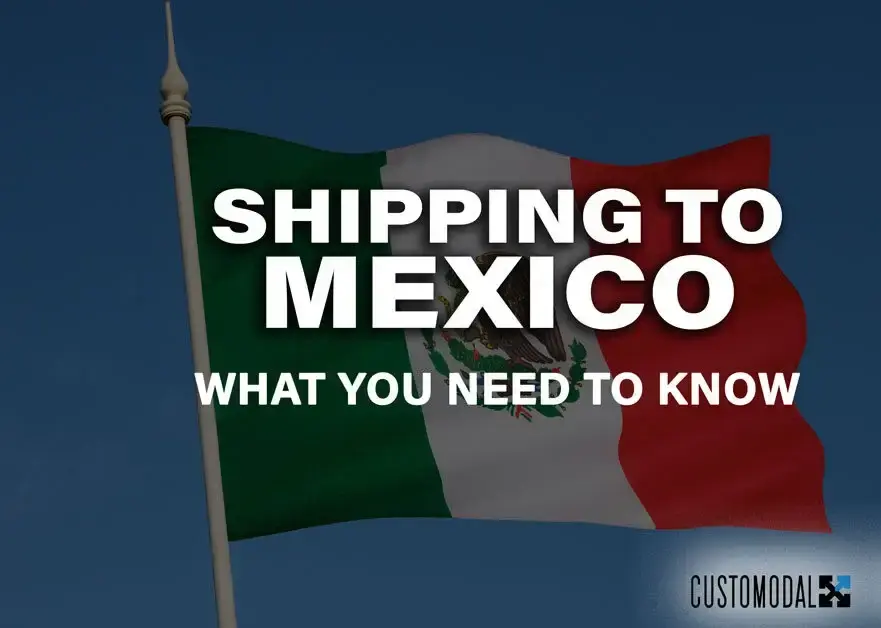
A Guide to Shipping to Mexico
Shipping freight to and from Mexico involves various considerations, and partnering with a third-party logistics (3PL) provider can streamline the process. Reach out to Customodal and we can help!
Are you planning to ship freight to Mexico? There are several aspects that make shipping to Mexico unique. With the United States’ western ports becoming increasingly busy and backed up, Mexico has become a hotspot for moving freight. Freight from China, for example, can arrive in a Mexican port and it’s not nearly as busy as Vancouver or LA. When shipping from the U.S. to Mexico, there are additional requirements. Having a logistics partner like Customodal to help you navigate the process can make a big difference.
Customs Brokers specialize in cross border paperwork specific to customs clearance, duties, and taxes. They frequently act as the collection agent for all those fees also. Customodal can work with any customs broker a client already has, and for those who need one we connect them to a strategic partner we work with. That partner customs broker can invoice through us so everything is neat and tidy on one invoice for the client.
Most freight shipping from the United States to Mexico is hauled via truckload, with nearly 35,000 trucks crossing the border every day. Though it’s a common occurrence, there are complex processes involved in getting goods across the border.
Here are some of the things that make shipping to and from Mexico unique:
First, there are many detailed documents and information required. You’ll need a Bill of Lading (BOL), a Commercial Invoice, Carrier Information, Certificate of Origin, and Customs Clearance – to name a few. Any mistakes on this paperwork can mean delays or worse. Each shipment is different, too, so some may require additional paperwork specific to the material being moved.
Additionally, many insurance carriers won’t insure a United States truck or trailer going into Mexico, which is why there is a whole network of locations where freight is unloaded and reloaded between trucks at the border. The US trucks pull in, unloads freight, and the freight then goes out on Mexican truck on the Mexican side of the border.
When freight is transferred from one trailer to another at a secure border facility, this is called “transloading.” At these facilities, a Mexican customs official inspects the freight prior to crossing.
Mexican truck drivers do not generally have a VISA to enter the United States, which is another reason there is almost always a separate crossing driver to take freight across the border. When transloading, the transfer takes place at the custom broker’s facility.
By contrast, a “through-trailer” means the freight stays in the same trailer throughout the entire cross-border shipping process (which is only possible when shipping from Mexico to the United States).
Shipping from Mexico is complex, but shipping to Mexico is VERY complex. Having a logistics partner that has experience with this process is critical. Contact our team at Customodal today and we’d be happy to help!
(Shipping to and from Mexico is a totally different experience than shipping to and from Canada. Learn more about exporting to Canada HERE.)
Shipping to Mexico
Here are some key aspects your company needs to know and how a 3PL can help:
- Customs and Regulations:
- Mexico has specific customs regulations that need to be adhered to. A 3PL can help ensure compliance with these regulations, including proper documentation and customs clearance.
- Documentation:
- Shipping to and from Mexico requires accurate and comprehensive documentation. A 3PL can assist in preparing the necessary paperwork, such as bills of lading, commercial invoices, and certificates of origin.
- Carrier Selection:
- Choosing the right carriers and transportation modes is crucial. A 3PL can leverage its network to find reliable carriers, negotiate rates, and optimize the transportation route for efficiency and cost-effectiveness.
- Cross-Border Transportation:
- Understanding the intricacies of cross-border transportation is essential. A 3PL can help coordinate the movement of goods across borders, managing the logistics of customs clearance and ensuring timely delivery.
- Warehousing and Distribution:
- If your company requires warehousing and distribution services in Mexico, a 3PL can provide storage solutions, order fulfillment, and distribution services to streamline your supply chain.
- Technology and Visibility:
- Many 3PLs utilize advanced technology for real-time visibility into your shipments. This allows you to track the movement of your freight, monitor inventory levels, and receive timely updates.
- Risk Management:
- Shipping across borders comes with inherent risks. A 3PL can help implement risk management strategies, such as insurance coverage and contingency planning, to mitigate potential issues.
- Cost Optimization:
- 3PLs often have experience and knowledge to optimize costs associated with transportation, warehousing, and other logistics processes. This can result in cost savings for your company.
- Network and Expertise:
- Leveraging a 3PL’s established network and expertise in cross-border logistics can provide your company with a competitive advantage. They can navigate challenges and offer solutions based on their knowledge of the region.
- Communication and Coordination:
- Effective communication and coordination are vital in cross-border logistics. A 3PL acts as a central point of contact, ensuring smooth collaboration between various stakeholders, including carriers, customs authorities, and your company.
By partnering with a 3PL that specializes in cross-border logistics, your company can benefit from their expertise, resources, and technology to navigate the complexities of shipping freight to and from Mexico efficiently and effectively.



